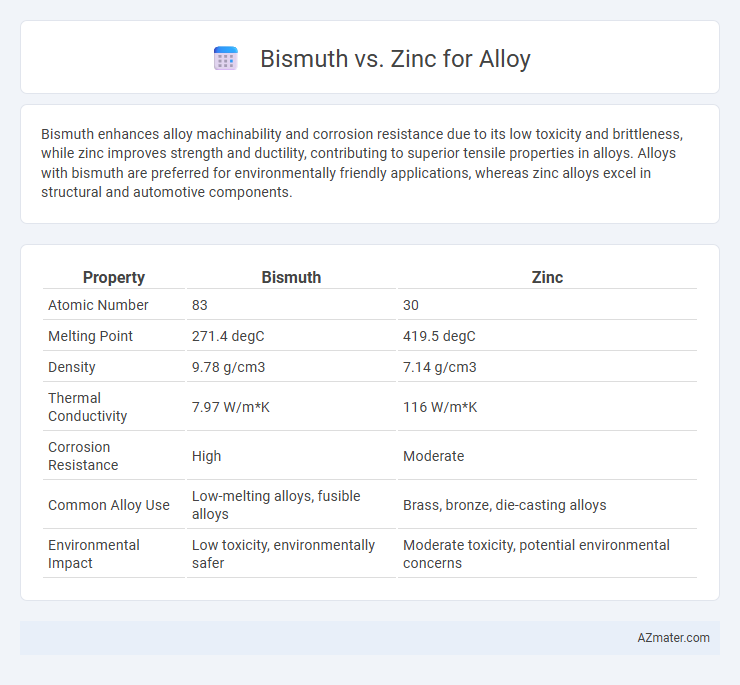Bismuth enhances alloy machinability and corrosion resistance due to its low toxicity and brittleness, while zinc improves strength and ductility, contributing to superior tensile properties in alloys. Alloys with bismuth are preferred for environmentally friendly applications, whereas zinc alloys excel in structural and automotive components.
Table of Comparison
| Property | Bismuth | Zinc |
|---|---|---|
| Atomic Number | 83 | 30 |
| Melting Point | 271.4 degC | 419.5 degC |
| Density | 9.78 g/cm3 | 7.14 g/cm3 |
| Thermal Conductivity | 7.97 W/m*K | 116 W/m*K |
| Corrosion Resistance | High | Moderate |
| Common Alloy Use | Low-melting alloys, fusible alloys | Brass, bronze, die-casting alloys |
| Environmental Impact | Low toxicity, environmentally safer | Moderate toxicity, potential environmental concerns |
Introduction to Bismuth and Zinc Alloys
Bismuth and zinc alloys are widely used in various industrial applications due to their unique mechanical and physical properties. Bismuth alloys are prized for their low melting points, excellent machinability, and non-toxicity, making them ideal for safe, eco-friendly metal castings and fusible plugs. Zinc alloys offer high strength, corrosion resistance, and good dimensional stability, commonly employed in die casting for automotive, electrical, and consumer products.
Chemical Properties of Bismuth vs Zinc
Bismuth exhibits low thermal conductivity and is highly resistant to oxidation, with a melting point of 271.5degC, making it valuable for alloys requiring stability at moderate temperatures. Zinc, with a melting point of 419.5degC, offers excellent corrosion resistance and notable galvanic protection due to its ability to form a stable oxide layer. The chemical inertness of bismuth contrasts with zinc's greater reactivity and ability to act as an anode in electrochemical reactions, influencing their respective performance in alloy formulations.
Melting Points and Alloy Casting Behavior
Bismuth has a melting point of 271.5degC, significantly lower than zinc's melting point of 419.5degC, making bismuth alloys easier to melt and cast at lower temperatures. Bismuth alloys exhibit minimal thermal expansion and excellent fluidity, which improves mold filling and reduces shrinkage defects during casting. Zinc alloys, although requiring higher melting temperatures, provide greater strength and hardness but may present challenges like oxidation and porosity during the alloy casting process.
Mechanical Strength and Durability
Bismuth alloys typically offer lower mechanical strength and reduced durability compared to zinc alloys, making zinc a preferred choice for applications requiring high wear resistance and structural integrity. Zinc alloys exhibit excellent tensile strength and toughness, contributing to longer-lasting performance in demanding environments. The combination of zinc's superior fatigue resistance and impact strength makes it more suitable for durable alloy components over bismuth-based alternatives.
Corrosion Resistance Comparison
Bismuth alloys generally exhibit superior corrosion resistance compared to zinc-based alloys due to their stable oxide layer formation, which protects against oxidation and harsh environments. Zinc alloys tend to corrode faster, especially in acidic or saline conditions, due to zinc's higher electrochemical reactivity. The enhanced corrosion resistance of bismuth alloys makes them preferable in applications requiring durability in moist or chemically aggressive atmospheres.
Environmental and Health Considerations
Bismuth alloys offer a non-toxic and environmentally friendly alternative to zinc-based alloys, as bismuth is naturally non-toxic and non-carcinogenic, reducing health risks during manufacturing and disposal. Zinc alloys, while commonly used, can release harmful zinc oxide fumes during melting, posing respiratory hazards and environmental concerns due to potential metal leaching. Choosing bismuth alloys supports sustainable production by minimizing hazardous emissions and enabling safer recycling processes.
Common Applications for Bismuth Alloys
Bismuth alloys are commonly used in applications requiring low melting points and non-toxicity, such as fire detection and suppression systems, pharmaceuticals, and cosmetics. These alloys also find use in precision casting, solders, and metalworking where environmental standards restrict lead content. In contrast, zinc alloys are preferred for die casting, automotive parts, and household hardware due to their strength and corrosion resistance.
Common Applications for Zinc Alloys
Zinc alloys are extensively utilized in die casting for automotive components, electronics housings, and hardware fittings due to their excellent dimensional stability and corrosion resistance. Common applications include manufacturing gears, pump parts, and door handles, where zinc's strength and low melting point enhance production efficiency. Unlike bismuth alloys primarily used in low-melting-point and specialized applications, zinc alloys dominate in structural and decorative parts requiring durability and cost-effectiveness.
Cost and Availability Factors
Bismuth, while less abundant than zinc, is generally more expensive due to limited global production and higher extraction costs, impacting overall alloy formulation expenses. Zinc, in contrast, benefits from widespread availability and lower market prices, making it a cost-effective choice for large-scale alloy manufacturing. The price stability and supply chain robustness of zinc further enhance its attractiveness over bismuth for economically optimized alloy applications.
Selecting the Right Alloy for Your Project
Bismuth and zinc alloys differ significantly in properties, with bismuth offering low toxicity and excellent machinability, making it ideal for environmentally friendly applications and precision components. Zinc alloys provide superior strength, corrosion resistance, and are cost-effective, suitable for structural parts and die-casting projects. Selecting the right alloy depends on project requirements like mechanical strength, environmental impact, and machining ease.

Infographic: Bismuth vs Zinc for Alloy
 azmater.com
azmater.com